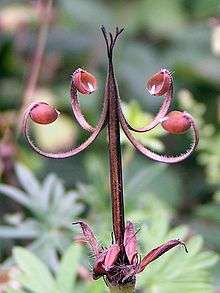Geranium sanguineum
| Geranium sanguineum | |
|---|---|
 | |
| Scientific classification | |
| Kingdom: | Plantae |
| (unranked): | Angiosperms |
| (unranked): | Eudicots |
| (unranked): | Rosids |
| Order: | Geraniales |
| Family: | Geraniaceae |
| Genus: | Geranium |
| Species: | G. sanguineum |
| Binomial name | |
| Geranium sanguineum L. | |
| Synonyms | |
| |
Geranium sanguineum, common names bloody crane's-bill[1] or bloody geranium, is a species of hardy flowering herbaceous perennial plant in the cranesbill family Geraniaceae.[2] It is also the county flower of Northumberland.[3]
Etymology
The genus name is derived from the Greek γέρανος ("géranos"), meaning crane, with reference to the appearance of the fruit capsule. The specific Latin name sanguineum refers to the red color assumed by the leaves in Autumn.
Description
The biological form of Geranium sanguineum is hemicryptophyte, as its overwintering buds are situated just below the soil surface and the floral axis is more or less erect with a few leaves. It has a thick rhizome. The stems are prostrate to ascending, well developed, very branched and hairy. This plant reaches on average 30–50 centimetres (12–20 in) in height.[4] The petiolate leaves have five lobes (or segments), each segment is tripartite in large teeth. The flowers have a diameter of 2.5 to 4 cm. and are purple[5] The flowering period extends from May through October. The flowers are hermaphrodite and pollinated by insects (entomophily). The most common flower visitors are Syrphidae and Hymenoptera, but also butterflies and Coleoptera. The fruit is a schizocarp that breaks up into five mericarps when ripe.[4]
Distribution
Geranium sanguineum is native to Europe and temperate Asia. It is widespread in most of Europe up to Caucasus. In the north-east of Ireland it is a rare garden escape.[6]
Habitat
The typical habitat of this species is grassland, sand dunes and open woodland on calcareous soils, including rocky slopes. It prefers calcareous soils with neutral pH, with low nutritional value, at an altitude of 0–1,200 metres (0–3,937 ft) above sea level.[4]
Cultivation
It is cultivated as a garden subject, and a number of different cultivars exist. The following cultivars have gained the Royal Horticultural Society's Award of Garden Merit:-
Gallery
- Plants of Geranium sanguineum
- Flowers of Geranium sanguineum
- Close-up on a flower of Geranium sanguineum – lateral view
 Fruits of Geranium sanguineum showing mericarps
Fruits of Geranium sanguineum showing mericarps- Leaves of Geranium sanguineum
 Leaves of Geranium sanguineum in Autumn
Leaves of Geranium sanguineum in Autumn
References
- ↑ "BSBI List 2007". Botanical Society of Britain and Ireland. Archived from the original (xls) on 2015-01-25. Retrieved 2014-10-17.
- ↑ "Geranium sanguineum". GRIN Taxonomy for plants. USDA ARS. Retrieved 15 July 2013.
- ↑ "Bloody crane's-bill | Plant & fungi species | Wild plants". www.plantlife.org.uk. Retrieved 2016-01-03.
- 1 2 3 Pignatti S. - Flora d'Italia – Edagricole – 1982. Vol. II, pag. 6
- ↑ Phillips, Ellen; Colston Burrell, C. (1993), Rodale's illustrated encyclopedia of perennials, Emmaus, Pa.: Rodale Press, pp. 373–76, ISBN 0-87596-570-9
- ↑ Hackney, P.1992."Flora of the North-east of Ireland." Institute of Irish Studies and The Queen's University of Belfast. ISBN 0-85389-446-9 (HB)
- ↑ "RHS Plant Selector - Geranium sanguineum 'Album'". Retrieved 15 July 2013.
- ↑ "RHS Plant Selector - Geranium sanguineum 'Ankum's Pride'". Retrieved 15 July 2013.
- ↑ "RHS Plant Selector - Geranium sanguineum 'Shepherd's warning'". Retrieved 15 July 2013.
- ↑ "RHS Plant Selector - Geranium sanguineum var. striatum". Retrieved 15 July 2013.
| Wikimedia Commons has media related to Geranium sanguineum. |